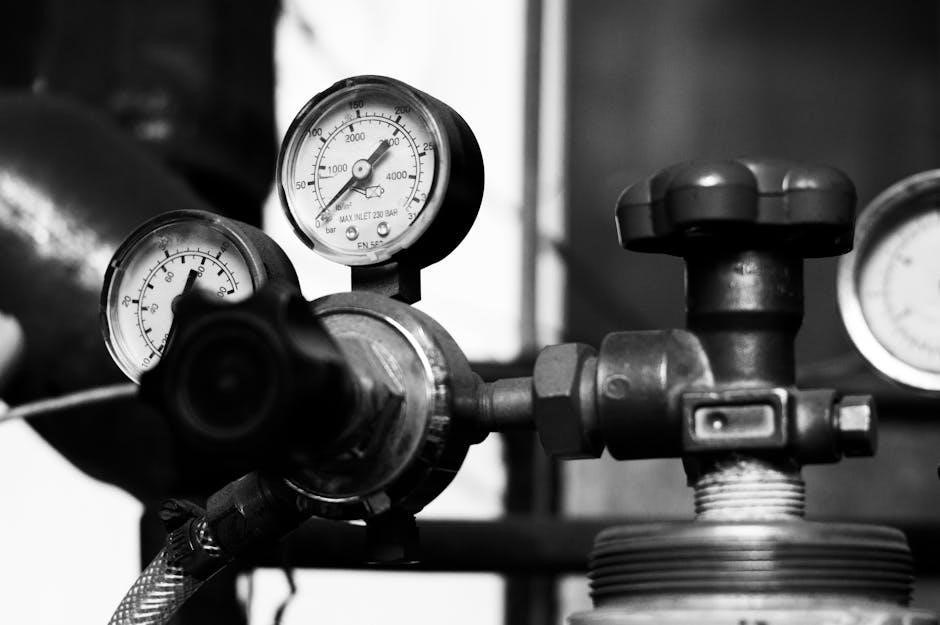The 4R70W is a four-speed automatic transmission used in various Ford vehicles, known for its durability and performance. A manual valve body offers precise control over gear shifts, eliminating electronic dependencies and enhancing driving responsiveness. This conversion is popular among enthusiasts for racing and high-performance applications, providing a cost-effective way to improve reliability and driver engagement.
Overview of the 4R70W Transmission
The 4R70W is a four-speed automatic transmission designed for rear-wheel-drive vehicles, offering a blend of durability and performance. It features a wide gear ratio spread, making it suitable for both daily driving and towing applications. The transmission relies on electronic controls for shift timing and torque converter lockup. Its compact design and robust construction have made it a popular choice for Ford vehicles. The 4R70W is also known for its smooth shifting and compatibility with various engine configurations, including V8s. A manual valve body conversion enhances its performance potential.
What is a Manual Valve Body?
A manual valve body is a mechanical component that replaces the electronic controls in an automatic transmission, such as the 4R70W, allowing the driver to manually control gear shifts. It eliminates the need for electronic solenoids and sensors, providing precise and instantaneous shifts. Companies like TransGo and Performance Automatics offer manual valve body kits for the 4R70W. This setup is ideal for racing or high-performance applications, as it enhances control and reliability while reducing electronic dependencies. It requires a shifter and manual input from the driver.

Benefits of Converting to a Manual Valve Body
Converting to a manual valve body enhances control, reliability, and performance by eliminating electronic dependencies. It provides direct driver input, reducing potential failures and offering a more engaging drive.
Enhanced Control and Responsiveness
Converting to a manual valve body provides direct driver input, eliminating delays caused by electronic controls. This results in faster and more precise shifts, enhancing overall responsiveness. With manual control, drivers can optimize gear changes for specific driving conditions, improving acceleration and performance. The mechanical nature of the system ensures consistent and reliable operation, making it ideal for racing and high-performance applications where instantaneous control is critical. This setup also reduces reliance on complex electronics, simplifying the driving experience.
Eliminating Electronic Dependencies
A manual valve body removes reliance on electronic controls, such as solenoids and sensors, simplifying the transmission’s operation. This reduces the risk of electronic failures and dependencies on complex wiring systems; By converting to a manual setup, drivers gain a more direct connection to the transmission, eliminating delays caused by electronic signals. This makes the system more reliable and less prone to malfunctions, especially in high-performance or racing environments where consistency is crucial. It also reduces long-term maintenance costs associated with electronic components.
Improved Reliability and Performance
Converting to a manual valve body enhances the 4R70W’s reliability by eliminating electronic dependencies that can fail over time. Manual operation reduces the risk of sudden gear shifts caused by faulty solenoids or sensors; This setup also delivers consistent performance, especially in high-stress conditions like racing, where precise control is critical. Drivers can expect smoother, more predictable shifts, reducing wear on internal components and improving overall transmission longevity. This makes it a popular choice for high-performance applications.

Installation and Setup of a Manual Valve Body
Installing a manual valve body on a 4R70W requires specific kits, such as the TransGo AODE-3, and careful wiring adjustments. The process can be complex due to the need for precise mechanical and electrical connections, ensuring smooth operation and reliability.
Required Kits and Components
To convert the 4R70W to a manual valve body, essential components include the TransGo AODE-3 kit, which provides the necessary valve body modifications. Performance Automatics offers a pre-built manual valve body designed for this transmission. Additional components like a ratcheting shifter (e.g., B&M or Hurst) and wiring harness adapters are required. The Lentech or Baumanator valve body kits are also popular for their durability and ease of installation. Ensure compatibility with your transmission model and vehicle setup for optimal performance.
Step-by-Step Installation Process
Begin by removing the transmission and disassembling it to access the valve body. Replace the stock valve body with the manual unit, ensuring all ports are properly aligned. Install the shifter mechanism, connecting it to the valve body. Wire the shift solenoids according to the kit instructions. Test the shifting function to ensure smooth engagement. Reassemble the transmission and reinstall it in the vehicle. Finally, bleed the system and test under various driving conditions to confirm proper operation.
Wiring and Compatibility Considerations
When installing a manual valve body, wiring modifications are necessary to eliminate electronic controls. The throttle position sensor (TPS) and vehicle speed sensor (VSS) may still be required for engine management. Ensure compatibility with your vehicle’s electrical system by using a standalone transmission controller or wiring harness designed for manual operation. Verify shift solenoid wiring to match the manual valve body’s specifications. Compatibility with Ford engines and aftermarket components must be confirmed to maintain proper functionality and avoid conflicts during installation.

Troubleshooting Common Issues
Common issues include failure to shift into overdrive, hard shifting, or missed gears. These problems often stem from wiring errors or improper manual valve body setup.
Failure to Shift into Overdrive
Failure to shift into overdrive is a common issue with manual valve bodies. This can occur due to incorrect wiring, faulty solenoids, or improper shift pattern configuration. Ensure the overdrive switch is functioning correctly and the valve body is calibrated properly. Additionally, verify that the transmission fluid level is adequate and clean. If issues persist, inspect the solenoid pack and wiring harness for damage or corrosion. Proper diagnosis and repair are essential to restore overdrive functionality.
Hard Shifting or Missed Gears
Hard shifting or missed gears in a 4R70W with a manual valve body can result from improper solenoid activation or misconfigured shift patterns. Ensure the shift solenoids are functioning correctly and the valve body is properly calibrated. Check for worn or damaged components, such as the shifter or gear engagement parts. Adjusting the shifter alignment and ensuring proper transmission fluid levels can also resolve these issues. Regular maintenance and inspection are crucial to maintain smooth gear transitions and prevent missed shifts.
Compatibility Problems with Other Components
When converting to a manual valve body, compatibility issues may arise with existing transmission components, such as shift solenoids, wiring, and the electronic control module. Ensure the manual valve body is designed for the 4R70W and that all connectors and interfaces align properly. Software compatibility with the vehicle’s PCM may require adjustments to prevent operational conflicts. Additionally, verify that the shifter and torque converter are compatible with the manual setup to maintain seamless performance and avoid mechanical failures.
Performance Enhancements with a Manual Valve Body
A manual valve body enhances performance by providing precise control over gear shifts, enabling quick and responsive transitions. It eliminates electronic delays, allowing drivers to optimize power delivery and acceleration, making it ideal for racing and high-performance applications.
Upgrading Shift Solenoids
Upgrading shift solenoids in a 4R70W manual valve body enhances shift precision and responsiveness. High-performance solenoids ensure faster and more accurate gear transitions, reducing lag and improving overall transmission efficiency. This upgrade is particularly beneficial for racing applications or high-stress driving conditions. While stock solenoids are reliable, aftermarket options offer superior durability and consistency. Proper installation and calibration are essential to maximize performance gains and ensure compatibility with the manual valve body setup.
Modifying the Valve Body for Racing Applications
Modifying the valve body for racing applications involves custom calibration and high-performance enhancements. Porting and machining improvements ensure precise fluid flow and pressure control, optimizing shift accuracy and speed. Racing-specific valve bodies often include upgraded springs, seals, and valves to withstand high-stress conditions. These modifications enhance the transmission’s ability to handle increased power and torque, delivering consistent and reliable performance on the track. Expert calibration is crucial to tailor the valve body’s behavior to specific racing demands and driver preferences.
Optimizing Gear Ratios for Specific Uses
Optimizing gear ratios for specific uses enhances the transmission’s performance in particular driving conditions. For racing, closer ratios improve acceleration and shift precision, while wider ratios suit highway driving or towing. Modifying the 4R70W’s gear ratios requires careful recalibration to match the vehicle’s power output and intended use. This ensures smooth power delivery and maximizes efficiency. Consulting with transmission specialists is crucial to achieve the desired performance without compromising reliability or drivability in various applications.
Shifter Options and Configurations
Shifters like the Hurst Pistol Grip RMVB or B&M offer precise control, with configurations for forward or reverse patterns. Compatibility with the 4R70W and wiring setup is crucial.
Choosing the Right Shifter for Your Setup
Selecting the ideal shifter for your 4R70W with a manual valve body involves considering your driving style and application. Popular options include the Hurst Pistol Grip RMVB and B&M shifters, which offer precise control and durability. For racing applications, reverse-pattern shifters like the C4 Pro Tree are preferred, allowing quicker shifts. Ensure the shifter matches your valve body’s shift pattern and is compatible with your vehicle’s interior setup for seamless integration.
Configuring Shift Patterns and Gates
Configuring shift patterns and gates for your 4R70W manual valve body ensures smooth transitions between gears. A forward pattern (P-R-N-3-2-1) is common, while reverse patterns are ideal for racing. Adjusting detent settings and shift gates is critical for precise control, preventing missed gears. Proper alignment and calibration ensure the shifter operates seamlessly with the valve body, delivering consistent performance. This setup allows drivers to tailor shifting characteristics to their driving style, enhancing both comfort and responsiveness.
Integrating Manual Controls with Other Systems
Integrating manual controls with other systems ensures seamless operation of the 4R70W transmission. The manual valve body works with the shifter, clutch, and torque converter for precise control. Wiring adjustments may be needed to align manual shifts with engine management systems. Compatibility with standalone control boxes or PCM interfaces is crucial for proper functionality. Ensuring synchronization between manual inputs and transmission responses enhances overall performance and driving experience, especially in high-performance or racing applications.
Maintenance and Upkeep of a Manual Valve Body
Regular inspections and fluid changes are essential for optimal performance. Diagnosing worn components early prevents major repairs. Flushing transmission fluid ensures smooth operation and longevity of the system.
Regular Maintenance Procedures
Regular maintenance ensures the longevity of the manual valve body. Start with fluid changes every 30,000 miles, using high-quality transmission fluid. Inspect the filter and replace it if necessary. Check for any signs of wear or leaks around the valve body and solenoids. Clean or replace the shift solenoids as needed to maintain crisp shifts. Visual inspections should be done every 15,000 miles to catch potential issues early. Proper upkeep ensures smooth, reliable performance and prevents costly repairs down the road.
Diagnosing and Replacing Worn Components
Diagnosing worn components in a manual valve body involves checking for irregular shifts, leaks, or unusual noises. Inspect the valve body for wear, and test solenoids for proper function. Replace damaged or corroded components promptly. Use specialized tools to remove and install parts like gaskets or seals. Regularly inspect the torque converter lock-up mechanism for wear. Addressing issues early prevents further damage and ensures smooth transmission operation. Always refer to a repair manual for precise diagnostic and replacement procedures.
Flushing and Refilling Transmission Fluid
Flushing and refilling transmission fluid is essential for maintaining the health of your 4R70W with a manual valve body. Start by draining the old fluid and replacing the filter. Use a transmission flush kit to clean the system thoroughly. Refill with high-quality ATF suitable for your transmission type. Regular fluid checks ensure optimal performance and prevent contamination. Always follow the manufacturer’s recommendations for fluid type and capacity to avoid damage. Proper maintenance extends the lifespan of your transmission and enhances its reliability over time.

Future Trends and Innovations
Advancements in manual valve body technology, integration with modern transmission systems, and increased potential for customization and tuning are shaping the future of 4R70W performance.
Advancements in Manual Valve Body Technology
Recent innovations in manual valve body technology for the 4R70W include improved shift precision, enhanced reliability, and customizable configurations. Kits like the TransGo Shift Kit offer refined control, reducing wear and tear. Modern designs focus on optimizing hydraulic circuits for smoother engagements and faster shifts. These advancements cater to both racing applications and everyday driving, ensuring consistent performance. As demand grows, manufacturers are developing more sophisticated solutions, making manual valve bodies a viable option for enthusiasts seeking improved transmission control and durability.
Integration with Modern Transmission Systems
Modern transmission systems increasingly rely on precise control and compatibility with electronic components. Manual valve bodies for the 4R70W are being adapted to integrate seamlessly with these systems, ensuring optimal performance. Shift kits and custom configurations enhance compatibility, allowing manual valve bodies to work alongside advanced transmission technologies. Proper setup and wiring ensure smooth operation, while maintaining the benefits of manual control. This integration supports both classic and modern vehicles, offering improved shifting and reliability in diverse driving conditions.
Potential for Customization and Tuning
The 4R70W manual valve body offers extensive customization options, allowing drivers to tailor shifting characteristics to their preferences. Performance companies like Performance Automatics and TransGo provide specialized kits for enhanced control. Shift solenoids can be upgraded for precise actuation, while custom calibration ensures optimal performance for specific applications. Drivers can fine-tune gear transitions, lockup points, and torque converter engagement, making it ideal for racing or high-performance setups. This adaptability ensures the manual valve body meets diverse driving needs effectively.
